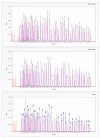Chromosomal 16p microdeletion in Rubinstein-Taybi syndrome detected by oligonucleotide-based array comparative genomic hybridization: a case report
- PMID: 22269667
- PMCID: PMC3295639
- DOI: 10.1186/1752-1947-6-30
Chromosomal 16p microdeletion in Rubinstein-Taybi syndrome detected by oligonucleotide-based array comparative genomic hybridization: a case report
Abstract
Introduction: Chromosomal aberrations of chromosome 16 are uncommon and submicroscopic deletions have rarely been reported. At present, a cytogenetic or molecular abnormality can only be detected in 55% of Rubinstein-Taybi syndrome patients, leaving the diagnosis in 45% of patients to rest on clinical features only. Interestingly, this microdeletion of 16 p13.3 was found in a young child with an unexplained syndromic condition due to an indistinct etiological diagnosis. To the best of our knowledge, no evidence of a microdeletion of 16 p13.3 with contiguous gene deletion, comprising cyclic adenosine monophosphate-response element-binding protein and tumor necrosis factor receptor-associated protein 1 genes, has been described in typical Rubinstein-Taybi syndrome.
Case presentation: We present the case of a three-year-old Malaysian Chinese girl with a de novo microdeletion on the short arm of chromosome 16, identified by oligonucleotide array-based comparative genomic hybridization. Our patient showed mild to moderate global developmental delay, facial dysmorphism, bilateral broad thumbs and great toes, a moderate size atrial septal defect, hypotonia and feeding difficulties. A routine chromosome analysis on 20 metaphase cells showed a normal 46, XX karyotype. Further investigation by high resolution array-based comparative genomic hybridization revealed a 120 kb microdeletion on chromosomal band 16 p13.3.
Conclusion: A mutation or abnormality in the cyclic adenosine monophosphate-response element-binding protein has previously been determined as a cause of Rubinstein-Taybi syndrome. However, microdeletion of 16 p13.3 comprising cyclic adenosine monophosphate-response element-binding protein and tumor necrosis factor receptor-associated protein 1 genes is a rare scenario in the pathogenesis of Rubinstein-Taybi syndrome. Additionally, due to insufficient coverage of the human genome by conventional techniques, clinically significant genomic imbalances may be undetected in unexplained syndromic conditions of young children. This case report demonstrates the ability of array-based comparative genomic hybridization to offer a genome-wide analysis at high resolution and provide information directly linked to the physical and genetic maps of the human genome. This will contribute to more accurate genetic counseling and provide further insight into the syndrome.
Figures



References
-
- Rubinstein JH, Taybi H. Broad thumbs and toes and facial abnormalities. A possible mental retardation syndrome. Am J Dis Child. 1963;105:588–608. - PubMed
-
- Hennekam RCM, Stevens CA, Van de Kamp JJ. Etiology and recurrence risk in Rubinstein-Taybi syndrome. Am J Med Genet Suppl. 1990;6:56–64. - PubMed
LinkOut - more resources
Full Text Sources
Research Materials

